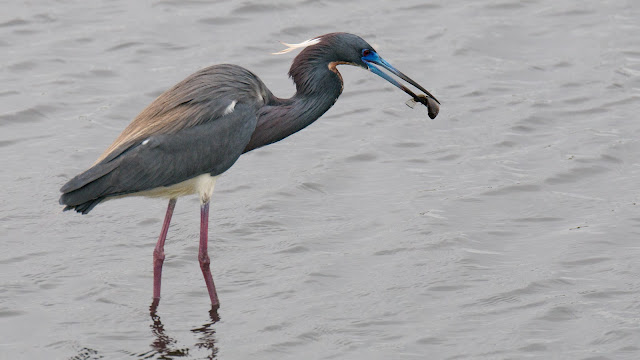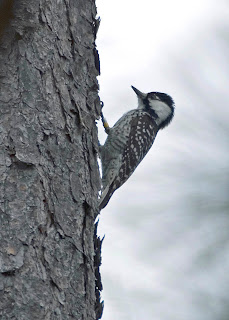April 21st – 27th
Well, it’s the final week of
April 2013 and we wonder “Where have these first four months of the year
gone?” It seems as if we just
arrived and headed down to the Space Coast Birding Festival….but that was 3 months
ago! It’s been a great year with
such rare highlights as the Vermillion flycatcher, White-cheeked pintail,
Thick-billed vireo, Cassin’s kingbird, Spot-breasted oriole, Gray kingbird, Western
kingbird, Long-billed curlew, and the Ash-throated flycatcher. We added six new
life-birds while here in Florida and visited several new preserves we had never
birded before. So….in summary,
it’s been a wonderful productive 3 ½ months. But we still had one week left, and so we took a last run
down to Merritt Island to see if we could pad the numbers.
At Merritt, we ended up with
just under 40 species on a chilly, windy and drizzly day. The numbers are down as many of those
species so common in the earlier part of the year have done what we are about
to do….head north. We did not come
across a single species of duck!
Waterfowl are so abundant down here in January that you cannot look upon
the waters of a single impoundment without spending an hour combing through the
throngs to pick out each and every new species. Coots numbering in the thousands during January and February
were non-existent today.
There are numbers of certain
species which are increasing as we enter into spring, however. Spoonbills seem to be more numerous
than previous months.
The number of tri-colored
herons was very high today. It
seemed that every open body of water was home to several of the species. Many are sporting their newly acquired
white plumes, typical of the breeding season.
The Eastern kingbird, absent
for the past three months, is happily once again on territory, a summer
resident across most of the United States. As the spring and summer wear on, these birds will become
more and more common.
 One other quite common species
was also found in some abundance at Merritt this week. Unfortunately, it was the feral hogs
that were out digging through the soil cover in search of grubs and roots. These mammals have become a major pest
in the southeast, doing considerable damage to forest, meadow and roadside
habitat. When they move through an
area, they leave behind plots of land that literally look as though a backhoe
had been used to excavate the land.
They are being hunted in an attempt to “cull the herd”, but they are
prolific breeders and we now see them almost every time we visit Merritt
Island.
One other quite common species
was also found in some abundance at Merritt this week. Unfortunately, it was the feral hogs
that were out digging through the soil cover in search of grubs and roots. These mammals have become a major pest
in the southeast, doing considerable damage to forest, meadow and roadside
habitat. When they move through an
area, they leave behind plots of land that literally look as though a backhoe
had been used to excavate the land.
They are being hunted in an attempt to “cull the herd”, but they are
prolific breeders and we now see them almost every time we visit Merritt
Island. Later in the week, we drove
north to Washington Oaks Gardens State Park in Palm Coast. With some strong north winds
accompanying stormy weather for the past couple of days, we had hoped to find
migrating songbirds taking cover here in the heavily wooded gardens. Sadly, we did not find too much we did
not already have. We did locate
Prairie, Black and White warblers, and our old buddy the Northern parula. The parulas are prevalent in the early
spring in Florida, truly one of the harbingers of the season. I had one of my closest encounters with
one at the gardens as the bird flew in within a couple of feet of me and landed
in a shrub…checking me out as much as I was him. Normally, these little guys
are difficult to see clearly as they prefer to forage in the canopy of the live
oaks, often feeding and hiding in the Spanish moss which adorns the limbs of
these massive trees. At such close
proximity, it was amazing to see exactly how tiny these warblers are. Many of these little beauties will join
Sharon and me as we head north next week, and we look forward to seeing or at
least hearing them in the hardwood forests of the northeast.
Later in the week, we drove
north to Washington Oaks Gardens State Park in Palm Coast. With some strong north winds
accompanying stormy weather for the past couple of days, we had hoped to find
migrating songbirds taking cover here in the heavily wooded gardens. Sadly, we did not find too much we did
not already have. We did locate
Prairie, Black and White warblers, and our old buddy the Northern parula. The parulas are prevalent in the early
spring in Florida, truly one of the harbingers of the season. I had one of my closest encounters with
one at the gardens as the bird flew in within a couple of feet of me and landed
in a shrub…checking me out as much as I was him. Normally, these little guys
are difficult to see clearly as they prefer to forage in the canopy of the live
oaks, often feeding and hiding in the Spanish moss which adorns the limbs of
these massive trees. At such close
proximity, it was amazing to see exactly how tiny these warblers are. Many of these little beauties will join
Sharon and me as we head north next week, and we look forward to seeing or at
least hearing them in the hardwood forests of the northeast. Later in mid-week, we had yet
another chase as a Neotropic cormorant had been reported along Biolab Road back
down in Merritt Island. The
directions were pretty explicit, so we hopped in the RAV and headed south. We scouted out the first possible cite
and came up with many Double-crested cormorants in various plumages. Several of the breeding males had the
tell-tale crests which in spite of their name are not seen very commonly. Plenty of other species were around,
but try as we may, we could not “morph” any of the DC’s into the desired
Neotropic. But we persisted, and
as luck would have it, we eventually spotted a noticeably thinner and smaller
cormorant perched on a piling right where the rare bird alert posting had
noted. Out came the scope and sure
enough, we got the visual confirmation we wanted…..our first Neotropic
cormorant in several years and the first we ever had in Florida. This sighting was doubly sweet as we
had chased the bird earlier this year down to Wakodahatchee Wetlands in DelRay Beach and came up
short.
Later in mid-week, we had yet
another chase as a Neotropic cormorant had been reported along Biolab Road back
down in Merritt Island. The
directions were pretty explicit, so we hopped in the RAV and headed south. We scouted out the first possible cite
and came up with many Double-crested cormorants in various plumages. Several of the breeding males had the
tell-tale crests which in spite of their name are not seen very commonly. Plenty of other species were around,
but try as we may, we could not “morph” any of the DC’s into the desired
Neotropic. But we persisted, and
as luck would have it, we eventually spotted a noticeably thinner and smaller
cormorant perched on a piling right where the rare bird alert posting had
noted. Out came the scope and sure
enough, we got the visual confirmation we wanted…..our first Neotropic
cormorant in several years and the first we ever had in Florida. This sighting was doubly sweet as we
had chased the bird earlier this year down to Wakodahatchee Wetlands in DelRay Beach and came up
short.  |
| Dark morph Short-tailed hawk |
The grand finale came when the
Swallow-tailed kites Steve had promised finally arrived. And what a show they
put on! First one, then another,
then several more all sailing gracefully as only kites can do right over our
heads and out over the lake. As
the sun was setting, we had 14 kites visible at the same time, kettling, then
peeling off only to rejoin shortly thereafter. It was truly and avian air show being staged as if totally
for our exclusive enjoyment. What
a way to wind down our three and a half months here in Florida!



























